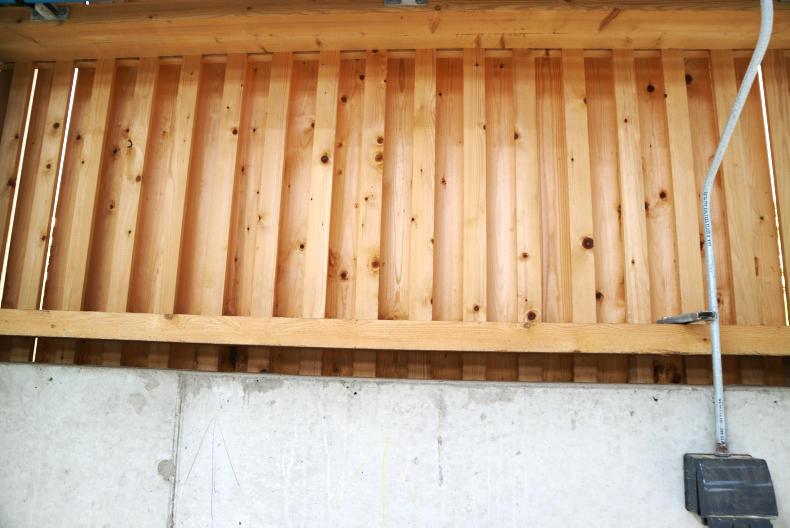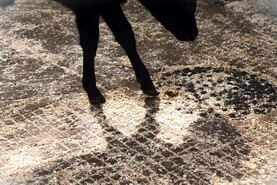For the majority of farmers diversifying into calf rearing, the plan is usually start small and build numbers once the system beds down.
While the ideal scenario would be to erect a modern purpose-built calf shed, limited cash reserves will mean most farmers getting into calf-rearing end up utilising existing sheds.
However, where existing sheds were previously used to house suckler cows and stores, facilities need to be altered to suit calves.
Outlined are a series of photographs with possible suggestions to consider when altering sheds.
Pictures 1 and 2:
increasing ventilation
Young calves will be highly stressed once they arrive on farm and this intensifies as stocking density increases in group pens.
Once stressed, the calf’s immune system is supressed, leaving it more susceptible to disease.

Picture two: Yorkshire cladding.
Pneumonia is common in young calves, especially when airflow in housing is inadequate. Therefore, improving airflow in calf sheds is an immediate priority.
Picture one shows panels that have been installed on the exterior walls of a lean-to shed. The panel rotates through 90° between a vertical and horizontal position, controlling airflow.
The panel is installed at a height that prevents calves being exposed to a draught, yet it is still effective at displacing stale air above each group pen.
This option may be more practical than the panelling in picture one and easier to install
Picture two shows Yorkshire cladding installed on external walls with the aim of increasing airflow. This option may be more practical than the panelling in picture one and easier to install.
Yorkshire cladding will increase airflow and when spaced properly, it will prevent rain and draughts from entering the shed.
Picture 3: installing fans
An alternative to installing timber cladding in calf sheds is to install extractor fans that will increase airflow over calf pens.

Picture three: extractor fan.
This may be an option where external walls and low roofing cannot be altered.
Picture 4: feeding gates
Where existing cattle sheds previously housed larger cattle, feed gates need to be replaced to allow young calves access to feed.
Replacing gates is a better option than using fodder racks inside group pens, as there will be less waste and forage can be offered ad-lib.

Picture four: feeding gates.
Picture four shows gates installed that allow calves access to fresh forage fed on an internal passageway.
In addition, meal troughs can be easily hung on the feed gate and removed after each use, keeping troughs clean.
Picture 5: clean water
As young calves will most likely be on a diet of straw and concentrates, it is important calves have constant access to fresh water.

Picture five: water.
Install drinking troughs in each pen. Place drinkers at a height that calves can access, but one unable to soil water with faecal matter.
Placing drinkers in every group pen will also cut down on disease transmission between pens, as will be the case with shared troughs.
Picture 6: water heater
Providing hot water for mixing milk powder is essential when rearing calves. Installing a water boiler means there is an adequate supply of hot water in calf sheds, speeding up calf feeding.

Picture six: water heater.
Picture 7: dividing gates
Hygiene in calf sheds is important to cut down transmission of disease between each intake.

Picture seven: dividing gates.
Dividing gates should be hinged at one end, so they can be easily folded back to allow for quick and easy cleaning of sheds using a telescopic handler. Once cleaned out, pens can be quickly set up again.
Read more
Beef Management: buying dairy beef calves, night feeding and minerals
Calf Health: Getting it right in spring 2020
For the majority of farmers diversifying into calf rearing, the plan is usually start small and build numbers once the system beds down.
While the ideal scenario would be to erect a modern purpose-built calf shed, limited cash reserves will mean most farmers getting into calf-rearing end up utilising existing sheds.
However, where existing sheds were previously used to house suckler cows and stores, facilities need to be altered to suit calves.
Outlined are a series of photographs with possible suggestions to consider when altering sheds.
Pictures 1 and 2:
increasing ventilation
Young calves will be highly stressed once they arrive on farm and this intensifies as stocking density increases in group pens.
Once stressed, the calf’s immune system is supressed, leaving it more susceptible to disease.

Picture two: Yorkshire cladding.
Pneumonia is common in young calves, especially when airflow in housing is inadequate. Therefore, improving airflow in calf sheds is an immediate priority.
Picture one shows panels that have been installed on the exterior walls of a lean-to shed. The panel rotates through 90° between a vertical and horizontal position, controlling airflow.
The panel is installed at a height that prevents calves being exposed to a draught, yet it is still effective at displacing stale air above each group pen.
This option may be more practical than the panelling in picture one and easier to install
Picture two shows Yorkshire cladding installed on external walls with the aim of increasing airflow. This option may be more practical than the panelling in picture one and easier to install.
Yorkshire cladding will increase airflow and when spaced properly, it will prevent rain and draughts from entering the shed.
Picture 3: installing fans
An alternative to installing timber cladding in calf sheds is to install extractor fans that will increase airflow over calf pens.

Picture three: extractor fan.
This may be an option where external walls and low roofing cannot be altered.
Picture 4: feeding gates
Where existing cattle sheds previously housed larger cattle, feed gates need to be replaced to allow young calves access to feed.
Replacing gates is a better option than using fodder racks inside group pens, as there will be less waste and forage can be offered ad-lib.

Picture four: feeding gates.
Picture four shows gates installed that allow calves access to fresh forage fed on an internal passageway.
In addition, meal troughs can be easily hung on the feed gate and removed after each use, keeping troughs clean.
Picture 5: clean water
As young calves will most likely be on a diet of straw and concentrates, it is important calves have constant access to fresh water.

Picture five: water.
Install drinking troughs in each pen. Place drinkers at a height that calves can access, but one unable to soil water with faecal matter.
Placing drinkers in every group pen will also cut down on disease transmission between pens, as will be the case with shared troughs.
Picture 6: water heater
Providing hot water for mixing milk powder is essential when rearing calves. Installing a water boiler means there is an adequate supply of hot water in calf sheds, speeding up calf feeding.

Picture six: water heater.
Picture 7: dividing gates
Hygiene in calf sheds is important to cut down transmission of disease between each intake.

Picture seven: dividing gates.
Dividing gates should be hinged at one end, so they can be easily folded back to allow for quick and easy cleaning of sheds using a telescopic handler. Once cleaned out, pens can be quickly set up again.
Read more
Beef Management: buying dairy beef calves, night feeding and minerals
Calf Health: Getting it right in spring 2020












 This is a subscriber-only article
This is a subscriber-only article










SHARING OPTIONS: